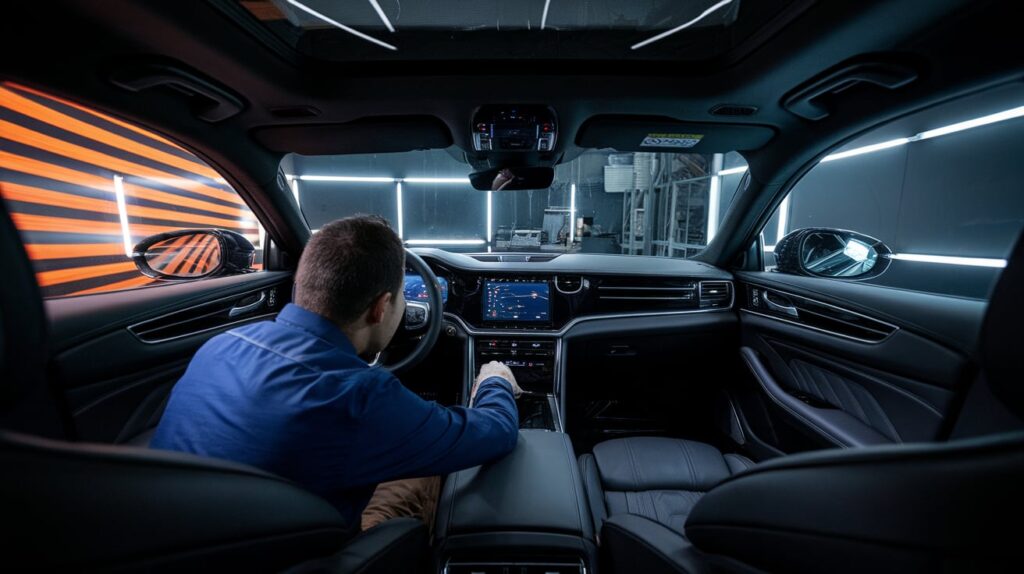Ever stepped into your car after it sat in the Dubai sun for just an hour? Feels like you’re roasting in an oven, right? Now imagine cutting that heat in half, without turning your car into a blackout box. That is where the real debate begins: infrared tint vs UV tint. Most drivers do not actually know the difference, and many end up choosing the wrong one for their needs. Before you spend a dirham on tinting, let’s talk about what actually works in this heat-soaked city.
What Is Infrared Tint?
You ever parked at City Centre Deira around noon, ran in for a “quick 15 minutes,” and came back to a steering wheel hot enough to cook a chapati? That heat? Blame it on infrared radiation. That is exactly what infrared tint is built to fight.
Unlike regular dark film, infrared tint is designed to block IR rays, the part of sunlight that heats up your car like a microwave. It’s not just about making your windows darker. It’s a heat-rejecting layer, usually ceramic-based, that filters out the radiation responsible for that oven-like cabin.
Here’s what makes infrared tint different:
- Blocks infrared radiation
The main goal is to stop radiant heat from entering through the glass, not just block light. - Keeps the cabin cooler
Cuts down heat buildup drastically, which means less stress on your AC, especially in Dubai traffic. - Clear or lightly tinted options available
You do not need pitch-black windows to stay cool. Many infrared films maintain visibility while still performing. - Uses advanced ceramic or nano-tech layers
These tech-heavy films are built for performance, not just aesthetics.
Infrared tint does not just “look good.” It works. It is the reason you see luxury cars staying cool without super dark windows. In Dubai’s brutal climate, this kind of tint is not a luxury, it is survival.
What Is UV Tint?
You ever noticed how your leather seats start cracking… even when your car barely hits 50,000 km? Or that faint discoloration on the dashboard you swear wasn’t there last month? That is UV damage, and no, your AC is not going to stop it. That is where UV tint steps in.
Unlike infrared tint, UV tint is not about heat. It is about protection. We are talking about blocking ultraviolet radiation, the sneaky, invisible rays that wreck your skin and ruin your car’s interior over time. Think of it as SPF for your ride.
What UV tint does best:
- Blocks up to 99% of UVA and UVB rays
That means lower risk of skin aging, sunburns, and long-term exposure damage, especially if you’re always stuck in Sheikh Zayed Road traffic. - Preserves interior materials
Fading dashboards, cracked leather, brittle plastic trims? UV tint slows that all down. - Doesn’t change your glass color
Most UV protection films are clear or nearly invisible. They do their job quietly, no dark shades required. - Can be layered under or over other films
Works well as an additional layer, especially when combined with infrared or ceramic tints.
Now, is UV tint going to stop your thighs from sticking to the seat in August? No. That is not what it’s built for. But if you care about protecting your car’s skin and yours, this layer plays a big role.
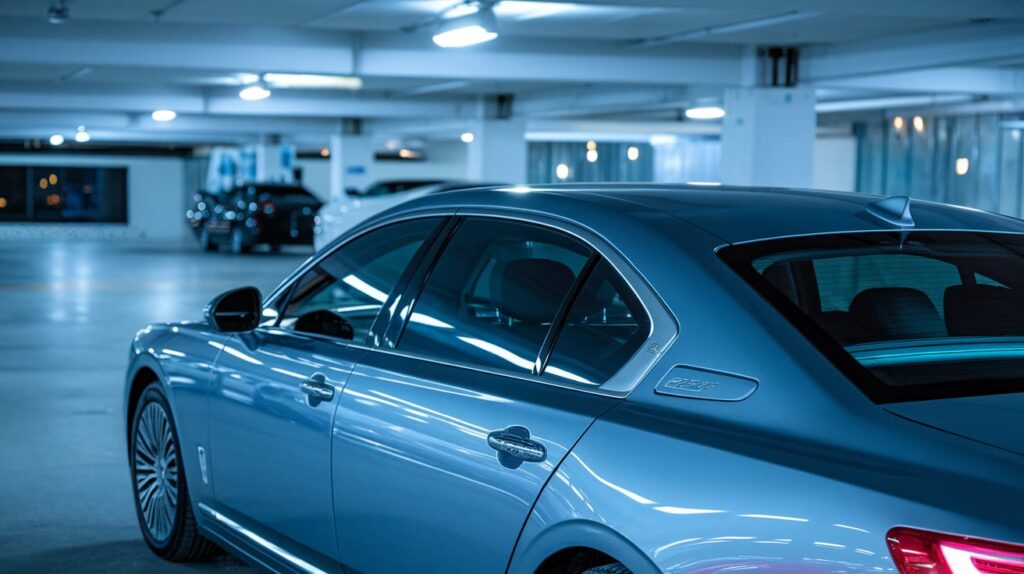
Heat Reduction Comparison | Which Tint Wins in Dubai Conditions?
When the Dubai sun is beating down at 45°C, your choice of window film becomes more than just cosmetic, it decides how much you’re sweating in traffic. Let’s break down the real-world heat rejection difference between infrared tint and UV tint in a side-by-side table:
| Feature | Infrared Tint | UV Tint |
| Main Purpose | Blocks infrared (IR) radiation to reduce heat buildup | Blocks ultraviolet (UV) rays for skin/interior protection |
| Heat Rejection (%) | 50%–80% (varies by film type and IR range) | 5%–15% (minimal direct heat reduction) |
| Cabin Temperature Impact | Noticeable drop, especially in parked vehicles | Slight difference, primarily filters light, not heat |
| AC Load Reduction | Reduces strain on cooling system | No significant effect on AC performance |
| Effectiveness in Dubai Heat | Highly effective, tailored for extreme sun | Less effective, UV is not main source of heat |
| Visibility vs Performance | High-performance films available with clear visibility | Usually clear; not designed for heat reduction |
| Recommended For | Daily drivers, outdoor parkers, long commutes | Skin-sensitive users, luxury interiors, budget layers |
Tip: In Dubai, infrared tint is the one that fights the heat. UV tint helps with sun damage, but it will not cool your cabin.
Coming up: How do these films handle glare and visibility, especially during night drives and sharp daylight reflections? Let’s get into that next.
Glare Reduction and Visibility During Day & Night
Ever driven down Hessa Street with the sun slapping your face like it’s personal? Or tried reversing at night, squinting through overly dark windows like you’re driving in a cave? Welcome to the never-ending battle of glare vs visibility, and your tint choice plays a huge part in it.
Now here’s the real question: Which tint helps you see better without turning your car into a tinted fishbowl?
Let’s break it down:
- Infrared Tint
- Reduces glare caused by direct sunlight, headlight reflections, and road glare.
- Maintains high visibility, even with lighter shades.
- Some ceramic IR films are engineered specifically for optical clarity at night.
- You get the benefits of heat and glare rejection without compromising sightlines.
- UV Tint
- Not built to block glare.
- Offers minimal to no help with visibility issues during bright daylight.
- Since most UV films are clear, they do not affect how you see, but also don’t reduce eye strain.
Dubai’s driving conditions are no joke. Between harsh sunlight, glass buildings, and aggressive traffic, glare becomes more than just a nuisance, it’s a safety risk. And if you’re using low-quality film just to save a few dirhams, you’ll feel it most when you can’t spot a lane change in time.
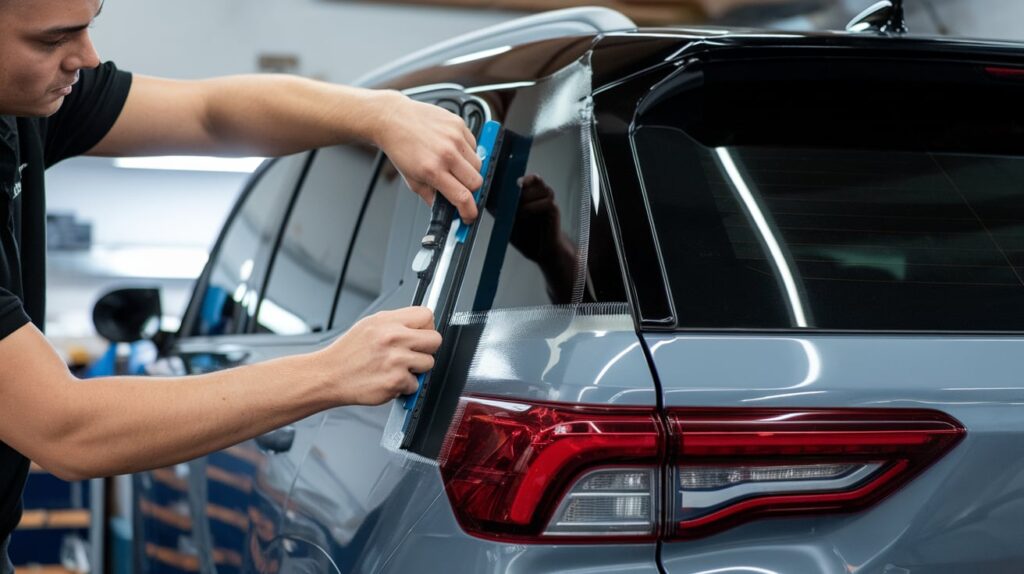
UV Protection | Which Tint Keeps You Safer from Skin Damage?
Let’s be honest, most people in Dubai underestimate how dangerous UV radiation is inside a car. You are sitting in what feels like shade, AC blasting, but those rays are still hitting your skin through the glass. Ever noticed that one side of your face tans more? That is not a coincidence.
When it comes to UV protection, there is a clear winner, but it depends on what kind of protection you are looking for. Here is how they stack up:
- UV Tint
- Specifically designed to block up to 99% of UVA and UVB rays.
- Slows down skin aging, lowers long-term cancer risks, and protects against sunburn.
- Also helps protect interior surfaces like dashboards, door panels, and seat stitching from cracking or fading.
- Perfect for families, daily commuters, or anyone who spends long hours behind the wheel.
- Infrared Tint
- High-end ceramic infrared films often include strong UV-blocking layers, even if it is not the main focus.
- You get both heat and UV protection if you choose the right film.
- However, if you pick a cheap IR-only film, UV shielding might not be included.
So what does that mean for you?
If you only care about UV rays, a dedicated UV tint does the job. But if you want full-spectrum protection, heat + UV + glare, go for a hybrid infrared ceramic film that comes with integrated UV defense.
Tint Appearance | How Do They Look on the Car?
Let’s be real, some folks want tint for the cool factor more than anything else. That sleek blacked-out look, the way reflections bounce off the glass, it just hits different. But for others, it is about performance first. So, where do infrared and UV tints land in the looks department?
Surprise: not all high-performance tints look dark. Here is what you need to know about appearance:
- Infrared Tint
- Often available in lighter shades with strong performance.
- Keeps your car looking classy and clean, not overly tinted.
- If you are driving a Range Rover or a luxury sedan, this is the go-to.
- Does not scream “aftermarket”, instead, it blends in with the OEM glass tones.
- UV Tint
- Mostly clear or near-transparent.
- Visually, it will not alter your car’s look at all.
- Great for people who do not want to darken their windows but still need skin and interior protection.
- Works silently, you won’t see it, but it’s there.
Now here’s the catch: many drivers assume darker tint = better protection. But that is a myth. You could have jet-black dyed film that does almost nothing for heat or UV. Meanwhile, a light ceramic IR film could be working ten times harder, even if it looks barely tinted.
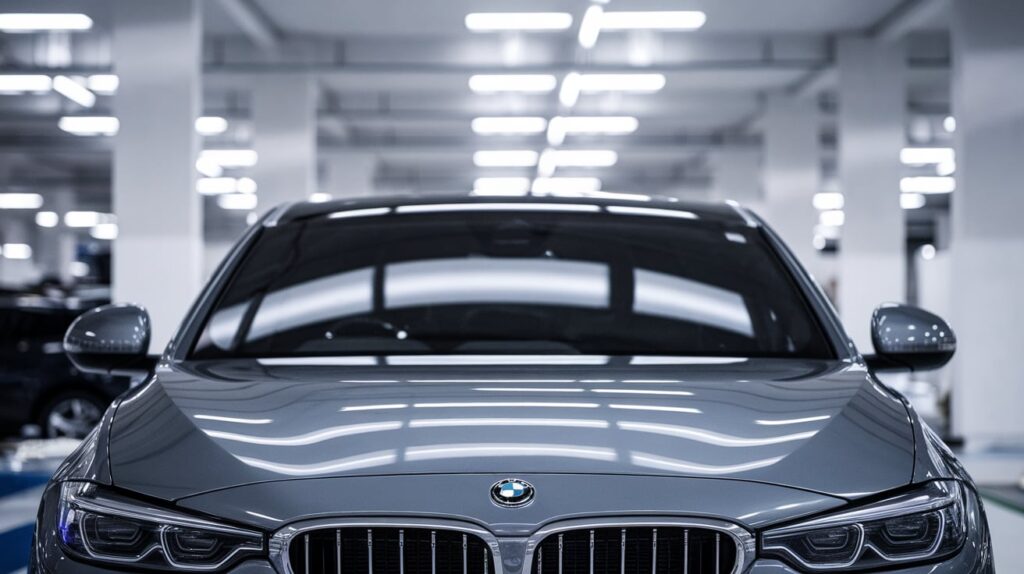
Cost Comparison | Is One More Budget-Friendly?
This is where most people pause. You walk into a tinting shop, ask for infrared tint, and boom, the price hits harder than the Dubai heat. But before you walk away thinking UV tint is the “cheaper and smarter” choice, let’s look at what you are really paying for. The difference is not just about price tags, it is about value over time. Here is the breakdown:
- Infrared Tint
- Usually priced between AED 900 to AED 2,500, depending on car size and film quality.
- Higher upfront cost, but it reduces AC use, protects against heat fatigue, and lasts longer without bubbling.
- Often includes UV protection already, so you are getting two layers of defense in one install.
- UV Tint
- Starts as low as AED 300 to AED 600.
- Budget-friendly option if your only goal is interior and skin protection.
- Won’t reduce heat much, so your AC keeps running harder, and your fuel bill climbs.
- May need replacement sooner, especially if exposed to full sun all day.
Let’s put it this way, UV tint is like a basic umbrella in a sandstorm. Infrared tint is a proper shelter. One keeps you dry for a few minutes; the other keeps you sane during Dubai’s 45°C madness. And when you weigh these differences, it’s natural to ask yourself: is car window tint really worth the investment? We’ve already broken this down in detail in our blog on whether car tinting is worth it, covering costs, benefits, and long-term value.
When to Choose Infrared Tint Over UV Tint
Let’s stop pretending one tint fits everyone. You park in the open all day? That is a whole different situation than someone doing school runs at 7 AM. The right choice between infrared tint and UV tint depends on how, and where, you actually drive.
So instead of throwing cash at the most expensive film or going cheap and regretting it, let’s match the tint to the real-life use case.
Choose Infrared Tint If You:
- Drive long distances during peak heat hours
You will feel the difference. Infrared tint cuts the cabin heat so your AC does not work overtime. - Park outdoors, especially on asphalt or rooftop lots
These surfaces amplify infrared radiation. IR tint keeps your cabin temp sane. - Own a luxury car or electric vehicle
You are already investing in comfort, this tint preserves battery life (in EVs) and protects high-end interiors. - Deal with glare or migraines
IR tint cuts that sharp daytime glare without making the car look pitch-black.
Choose UV Tint If You:
- Just want interior and skin protection
Daily short trips? Garage parking? UV tint gives basic protection at a low cost. - Are looking for a temporary solution
Maybe it is a rental. Or maybe you plan to upgrade soon. UV tint keeps things in check without overcommitting. - Have budget limits but want some protection
It is a practical step up from bare glass, even if it won’t help much with heat.
Real talk? In Dubai, UV tint alone does not cut it for most drivers. But combining both? That is smart. Many high-performance infrared films come with UV layers built in, so you get full coverage.
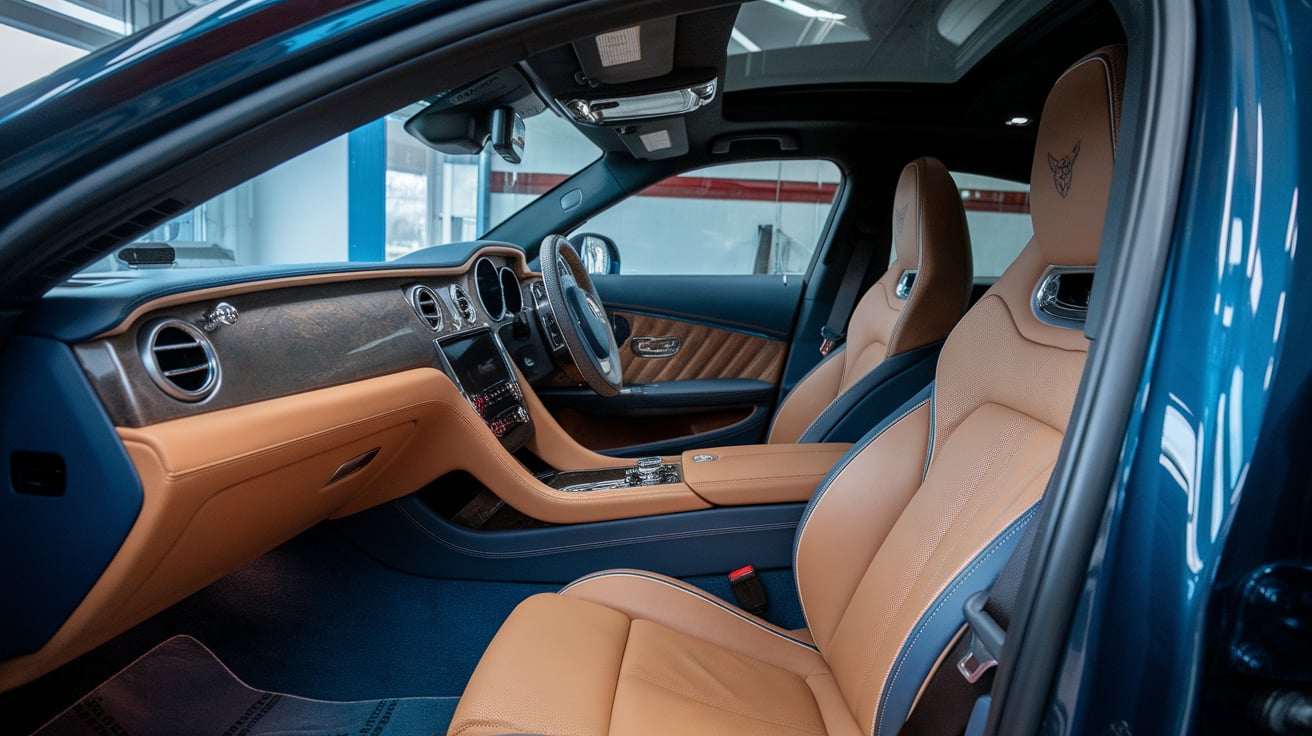
Where to Get It Done Right? Book a Tinting Consultation in Dubai
You have got enough going on, last thing you need is to waste a weekend sweating it out in a car that’s tinted but still feels like a greenhouse. If you are serious about blocking heat, protecting your skin, and keeping your car’s interior looking new, then it comes down to installing the right film, the right way. That is where Car Tinting Heroes step in. We do not just throw any film on your glass and call it a day. We test, we install under controlled conditions, and we explain exactly what you are getting.
Here is what we offer:
- Full range of infrared and UV tint films tested for Dubai’s heat
- Hybrid ceramic tints that offer both heat and UV protection
- Indoor, dust-free installation bays to prevent bubbles and peeling
- Detailed heat rejection stats, no guesswork, just real numbers
- Options for light, medium, or dark finishes without sacrificing clarity
Whether you’re driving a Camry, a Cayenne, or a Tesla Model Y, we’ve got options that work. And yes, we tint all car types, sedans, SUVs, sports, and even commercial fleet vehicles.

